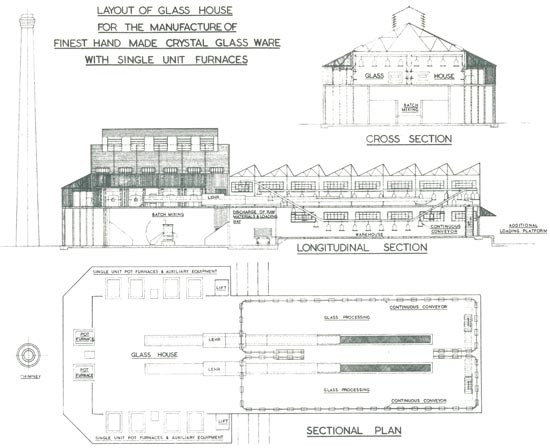|
hand pressed section of the industry here. We do not, however, believe that there is any need to fear any competition arising between the two sections. The hand-blown industry caters for a different market, producing goods of high quality in lead crystal, a considerable proportion of which is hand decorated, whilst the hand pressed industry confines its activities, for the most part, to the production from soda-lime glass of much cheaper goods without any applied decoration. The hand pressed and decorated lead crystal ware would, we consider, be creating a new market and not entering an existing one.
MACHINERY PRODUCTION AND SUPPLY
We recommend the introduction of mechanical processes so far as it is practicable to replace or supplement hand production in the existing factories, and also (see Chapter 8) the setting up of a new factory co-operatively run and equipped for semi-automatic production. Some reference is therefore necessary to the possibility of obtaining in this country the machinery and plant which will be needed if these recommendations are to be carried into effect.
Ancillary equipment including lehrs, conveyors, cracking-off, grinding and edge-melting machines used in our factories, is mostly derived from home sources. Glass-forming machinery, on the other hand, which, particularly in the container industry, forms the most expensive item in the equipment of semi or fully automatic glass factories, has hitherto largely been imported, principally from the United States and Canada.
It is obviously desirable that we should aim at becoming less dependent on foreign sources of glass machinery, especially when embarking on new mechanical production involving the design and manufacture of new types of machines. There are only a few firms, all of them relatively small, making glass-forming machinery in this country. Some of these, however, should, with the help and encouragement of the industry, be quite capable of providing the equipment which will be required.
The design, production and development of an entirely new type of automatic glass-forming machine of a kind which is likely to prove of use to this section of the glass industry might cost anything up to £10,000 or £20,000. None of the firms making glass-forming machinery in this country is in a position to spend this sum of money on developing such a machine, particularly since the prospect of large sales is slight. Considerable financial support would, therefore, be necessary for such a project; but progress step by step through various stages of mechanisation would, however, appear to be inevitable.
To avoid delay, consideration should, as an interim measure only, be given to the importation and adaptation of suitable machinery from the United States. Our delegation to that country saw several types of machines which should be of interest in this direction. Arrangements should, if possible, be made with the American manufacturers to have these machines built here, but failing this, machines could be imported for trial and use, pending the development of British types.
VENTILATION OF THE GLASSHOUSE
The old method of ventilation relied on the stack through which the furnace gases were withdrawn, but to-day temperatures in the glasshouse are kept down
|




